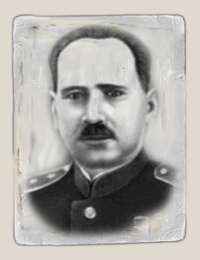Semyon Kozak
 23.5.1902 - 24.12.1953 23.5.1902 - 24.12.1953Semyon Kozak was Commander of the 73rd Guards Rifle Division, Guards Major-General. He was born on May 23, 1902 in Iskorost village (today Korosten-city, the Zhytomyr Region) in a working class family. Ukrainian. A member of the CPSU (B) since 1923. Participated in the Civil War as a common soldier. Joined the Red Army in 1924. After completing secondary school he entered the military artillery school. He graduated from it in 1928, and then served as a political commissar and commander of an artillery battery, division, tank battalion, worked as a Tank Technical School teacher. In 1933 he graduated from the Advanced Training Courses for commanders and in 1938 - the Military Academy named after M. Frunze where he taught until 1941, then he worked in the headquarters of PDC of the USSR. Was in the army since October 1942. S. Kozak participated in the battles on Stalingrad, Steppe, Voronezh, the 2nd and the 3rd Ukrainian Fronts. He was deputy chief of staff of the 64th (7th Guards) Army. On April 18, 1943, Colonel S. Kozak commanded the 73rd Guards Rifle Division on the 2nd Ukrainian Front. He demonstrated high organizational skills, courage and determination in the counteroffensive at Stalingrad and Kursk. Kozak’s leadership talent clearly manifested during the battle for the Dnieper. Advanced units of the 73rd Guards Rifle Division having successfully overcome the water barrier, unexpectedly hit the flank of the enemy and attacked from the rear. The Nazis suffered heavy losses. The bridgehead was retained and expanded. Divisional Commander, S. Kozak all the time was among the attackers, inspiring the fighters by personal example. On October 25, 1943, Colonel S. Kozak was awarded the rank of Major-General. By the Decree of the Presidium of the Supreme Soviet on October 26, 1943 for the successful crossing of the Dnieper River and fasten the extension of the bridgehead on the west coast, and for his bravery and courage, Semyon Kozak was awarded the title of Hero of the Soviet Union, the Order of Lenin and the Gold Star medal (№ 1341). Later, commanding a division, S. Kozak participated in offensive operations to liberate the Right-Bank Ukraine, Romania, Bulgaria, Hungary, Yugoslavia and eastern regions of Austria. The division distinguished itself while forcing the Southern Bug, the Dniester, the Prut, the Seret, the Tis, and especially - the Danube. Major-General S. Kozak skillfully arranged its forcing in the fall of 1944. Simulating the crossing of the Danube in one place, the division crossed to another site, expanded the beachhead, and firmly established on it reflecting all the attacks. For his leadership while crossing the Danube, hos courage and heroism Semyon Kozak was awarded a second Gold Star medal (№ 4964) by the Decree of the Presidium of the Supreme Soviet of the USSR on April 28, 1945. At the final stage of the Great Patriotic War, S. Kozak commanded the 21st Guards Rifle Corps. After the war, Lt. Gen. S. Kozak commanded the Infantry Corps, the army; in August 1950 he became assistant commander of the Far Eastern Military District. He was elected a deputy of the Supreme Soviet of the USSR (third convocation). He died on December 24, 1953 in Yuzhno-Sakhalinsk. He was buried in Moscow at Novodevichy Cemetery. He was awarded two Orders of Lenin, four Orders of the Red Banner, the Order of Suvorov, the 2nd Class Orders of Kutuzov and Bogdan Khmelnitsky, and medals. Awarded the title of People’s Hero of Yugoslavia. A bronze bust of twice Hero of the Soviet Union, S. Kozak was installed in his home city - Korosten. The streets in Volgograd and Korosten are named after him. |




